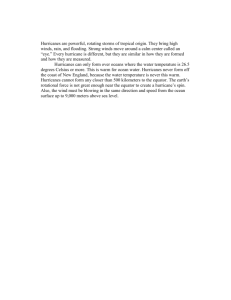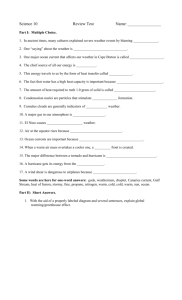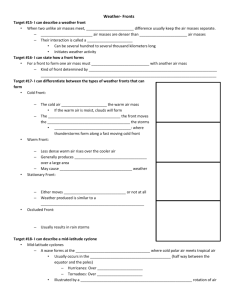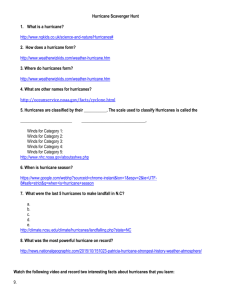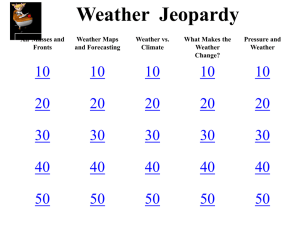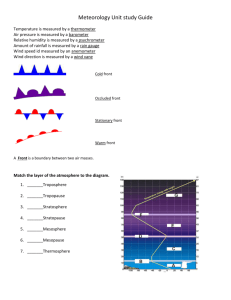Weather Test Review #1 with answers
advertisement
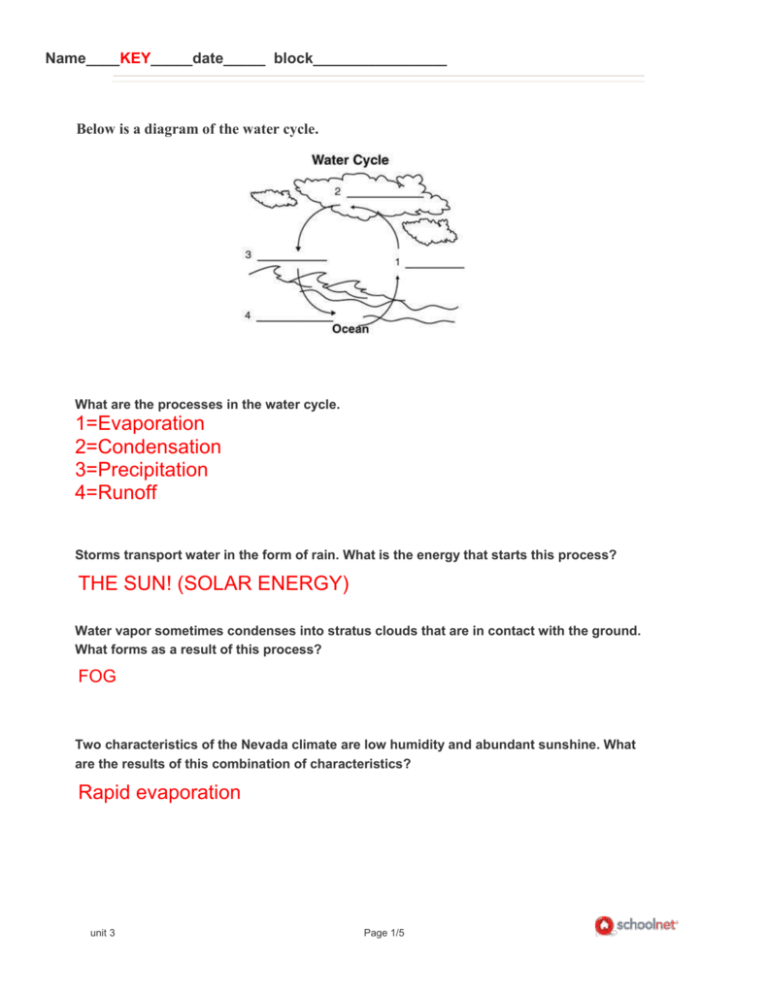
Name____KEY_____date_____ block________________ Below is a diagram of the water cycle. What are the processes in the water cycle. 1=Evaporation 2=Condensation 3=Precipitation 4=Runoff Storms transport water in the form of rain. What is the energy that starts this process? THE SUN! (SOLAR ENERGY) Water vapor sometimes condenses into stratus clouds that are in contact with the ground. What forms as a result of this process? FOG Two characteristics of the Nevada climate are low humidity and abundant sunshine. What are the results of this combination of characteristics? Rapid evaporation unit 3 Page 1/5 Ocean currents affect global climates. The Great Ocean Conveyor Belt is shown. What is the mechanism that drives the current to continue to circulate? Surface winds The diagram below shows a very cold air mass moving over a large, warm lake. When cold air in the winter passes over large bodies of warm water, moisture is picked up. As the air rises rapidly over land, what happens? Precipitation Which condition is associated with most warm fronts? Cloud formations with precipitation unit 3 Page 2/5 Hurricanes form over water and lose wind speed when they move over land. What does this pattern best illustrate? Oceans transfer more energy than land will St. Augustine, Florida, and San Antonio, Texas, are located near the same latitude. However, average winter temperatures in St. Augustine are higher than in San Antonio. Which most influences the milder temperatures of St. Augustine, Florida? Nearness to Ocean Currents . Hurricanes are large tropical storms with heavy winds that exceed 74 miles per hour. Hurricanes produce heavy rains and may give rise to tornadoes. What is the source of the energy contained in hurricanes? Thermal energy of ocean waters What is the primary source of stored thermal energy in oceans? The sun . Meteorologists categorize hurricanes based on the Saffir-Simpson scale. The scale measures the intensity and destructive potential of hurricanes. Which factors have the most significant effect on the strength of a hurricane? The temperature of the water that is below the hurricane. unit 3 Page 3/5 15. Hurricane season for the Atlantic Ocean lasts from June to November. Which factors make an Atlantic hurricane less likely to form during the month of March? Cool ocean waters 16. In regions where prevailing winds blow from the oceans to the shore, what is most likely to occur? Heavier rainfall 16. Hurricanes form over equatorial areas. This is because…. Solar heating is greatest at the equator 17. An air mass travels north over the Pacific Ocean, from the tropics, and then eastward across the United States. Which weather pattern can be expected? Warm and wet 19. What most likely happens when a cold air mass comes into contact with a warm, moist air mass? Rain or snow begins to fall 19. What happens to a moist air mass as it moves upward in the atmosphere? It becomes cooler and forms clouds 20. The reading on a barometer rises when the air …. Pressure increases unit 3 Page 4/5 21. How do the conditions for a tornado differ from the conditions for a hurricane? Tornados=land Hurricans=water 22. In the centers of North America and Asia, large regions of land have relatively dry climates. What are the results of the lack of rainfall? The distance from oceans prevents moist air from reaching the center of continents, creating a desert climate 23. Clay is watching the weather to prepare for a trip to the beach tomorrow. The forecast predicts that a low-pressure system will move in overnight. Which type of weather can Clay most likely expect in the morning? Rainy 24. As a warm moist air mass moving northward collides with a strong cold air mass moving southward, what observations will most likely be made? Clouds begin to form Know the name and be able to identify clouds by their pictures. unit 3 Page 5/5
